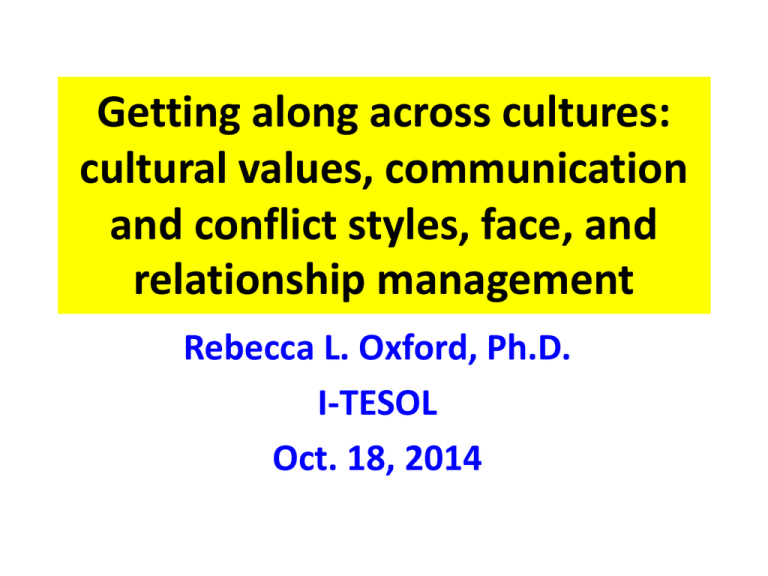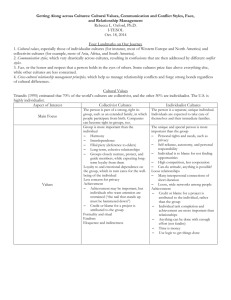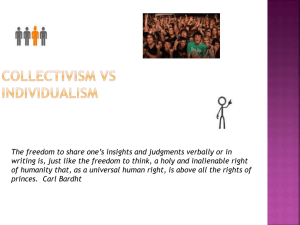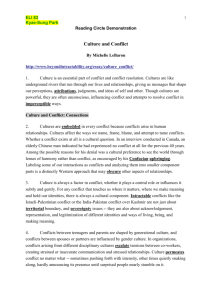Cross-Cultural Understanding and Conflict Resolution
advertisement

Getting along across cultures: cultural values, communication and conflict styles, face, and relationship management Rebecca L. Oxford, Ph.D. I-TESOL Oct. 18, 2014 Getting along across cultures This exciting presentation takes us on a cultural journey with four main stops. • Our first stop is the realm of cultural values, especially those of individualist cultures (for instance, most of Western Europe and North America) and collectivist cultures (for example, most of Asia and South America). • The second landmark on our journey is communication styles, which vary drastically across cultures, resulting in confusions that are then addressed by different conflict styles. Getting along across cultures • Next on our journey we visit the strange and sometimes amazing phenomenon known as face, or the honor and respect that a person holds in the eyes of others. Some cultures prize face above everything else, while other cultures are less concerned. • Our journey then brings us to cross-cultural relationship management principles, which help us manage relationship conflicts and forge strong bonds regardless of cultural differences. By the close of our journey, we have become experts on getting along across cultures. What is the main difference between these two? What percentage of the world’s cultures fall into each category? Collectivist vs. Individualist • Triandis (1995) estimated that 70% of the world’s cultures are collectivist, and the other 30% are individualist. Strongly or Somewhat Collectivist (in relation to the world mean of 43) Guatemala 6; Ecuador 8; Panama 11; Venezuela 12; Colombia 13; Indonesia and Pakistan 14 (tie); Costa Rica 15; Peru and Trinidad 16 (tie); Taiwan 17; South Korea 18; El Salvador 19; Bangladesh, China, Singapore, Thailand, Vietnam, and West Africa 20 (tied); Chile 23; Hong Kong 25; Malaysia 26; East Africa and Portugal 27 (tie); Bulgaria, Mexico, and Romania 30 (tie); Philippines 32; Greece 35; Arab World and Brazil 38 (tie); Jamaica and Russia 39 (tie) Hofstede, 2009 Strongly or Somewhat Individualist (in relation to the world mean of 43) United States 91; Australia 90; United Kingdom 89; Canada, Hungary, and the Netherlands 80 (tie); New Zealand 79; Italy 76; Belgium 75; and Denmark 74; France and Sweden 71 (tie); Ireland 70; Norway 69; Switzerland 68; Germany 67; South Africa 65; Finland 63; Estonia, Luxembourg, and Poland 60 (tie); Malta 59; Czech Republic 58; Austria 55; Israel 54; Spain 51 Hofstede, 2009 Collectivist Cultural Values • Collectivist cultures focus on the person as part of a social group. – Collectivist cultures are comprised of strong, tight in-groups, such as extended families, in which people participate from birth. – These in-groups closely nurture, protect, and guide their participants, while in return expecting long-term loyalty from the participants. Collectivist Cultural Values • Group is more important than the individual – – – – Harmony Interdependence Filial piety (deference to elders) Long-term, cohesive relationships • Loyalty to and emotional dependence on the group, which in turn cares for the well-being of the individual – The well-known Japanese personality trait of amae reflects an accepted dependence on an older, protective person – People in highly collectivist cultures seek advice from elders or others in the in-group before making major decisions • Less concern for privacy Collectivist Cultural Values • If a given individual seems to garner too much attention based on excellent performance or other individual factors, social forces must restrain him or her (“the nail that stands up must be hammered down”) • Credit or blame for a project is attributed to the group, rather than the individual – If one member of a team instead of the whole team receives an honor, this situation can be humiliating or upsetting to the rest of the team Some Values And Beliefs in Many Collectivist Cultures M AJOR CULTURAL VALUE: Importance of personal relationships with others in the group CULTURAL BELIEF ABOUT RELATIONSHIPS: Mutual care, concern, and support are necessary CULTURAL BELIEF ABOUT RELATIONSHIPS: Relationships with people in the group are timeless 12 Collectivist Cultural Values • • • • Formality and ritual Fatalism Priority on personal relationships Eloquence and indirectness 13 Self in Collectivist Cultures Father X Mother X X XX X X Friend X X Self Sibling XX X X X X X XX X Friend X X X Coworker X X X X Interdependent Self-Construal in Collectivist Cultures Source: Adapted by Rebecca L. Oxford from Markus and Kitayama (1991) Individualist Cultural Values • Individualist cultures center on the person as a separate, unique individual. –Individualist cultures focus on the individual person rather than the group. –In individualist cultures, comparatively loose ties connect individuals, who are expected to take care of themselves and their immediate families. Individualist Cultural Values • The individual is independent, unique, and special – – – – Personal rights and needs, such as privacy Self-reliance, autonomy, and personal responsibility High competition, less cooperation Can-do attitude, anything is possible! • Relationships – Many interpersonal connections of short duration – Loose, wide networks among people, unlike the longterm, cohesive relationships found in collectivist cultures. Individualist Cultural Values • Credit or blame for a project is attributed to the individual, rather than the group – Individual task completion an d achievement are m ore important than relationships • The value of equal opportunity for individuals is espoused by certain individualist cultures, but these cultures also promote other values that might contradict equal opportunity – Each individual is responsible for finding or creating his or her own opportunities, e.g., for an education or a career – If opportunities do not occur, the individual is somehow at fault for not trying hard enough to find or generate them Some Values and Beliefs in Many Individualist Cultures MAJOR CULTURAL VALUE: Importance of time Not the same in all cultures! CULTURAL BELIEF ABOUT TIME: Time is money CULTURAL BELIEF ABOUT TIME: Time must be spent wisely (efficiency) Belief in efficiency becomes so strong that it becomes another CULTURAL 19 VALUE Individualist Cultural Values Self in Individualist Cultures Self Mother X XX X X Friend X X X Father X X XX X X X X X XX Friend X X Sibling X X Coworker X X X Independent Construal of Self = Image of Self as Independent of Others Independent Self-Construal in Individualist Cultures Source: Adapted by Rebecca L. Oxford from Markus and Kitayama (1991) VALUE CLASH! • What happens in a situation in which people from collectivist and individualist cultures have to work together? How do their values clash? • If you were in charge, how could you help them overcome such a clash? High-Context Communication (Collectivist Cultures) • High-context communication is largely indirect, with much of the message unsaid and with many meanings and values implicitly shared by others in that culture – but not by outsiders. High-Context Communication (Collectivist Cultures) • Most of the meaning is not communicated through the words themselves • Meaning is communicated through . . . – – – – – – – facial expression, posture, eye contact, physical context tone of voice, status, and eloquence (Hall, 1976) High-Context Communication (Collectivist Cultures) • Typical high-context communication: – Eloquent phrases and politeness rituals are expected – Lots of time given for introductory relationshipbuilding, while simultaneously assessing the social characteristics of the other party. – Decisions focus on face-to-face relationships, often around a central authority figure – Collaborative solutions to problems, not focused on the individual – Many details left out (only implied or metaphorically stated) – Disagreement often not stated openly High-Context Communication (Collectivist Cultures) • Based on the idea that truth emerges nonlinearly, without necessitating consistency or firm logic • Dialectical thinking, or the acceptance of cognitive dissonance (presence of simultaneously incongruous ideas), is more frequent in highcontext communicators than low-context communicators • Low-context (individualist) communicators often become impatient with high-context (collectivist) communicators or think they are being deceptive Low-Context Communication (Individualist Cultures) • In low-context communication, most of the information is in the explicit code, i.e., is openly expressed – No need for many contextual cues from tradition, the physical environment, nonverbal behavior, social status, or family background (Hall, 1976). • Decisions are largely made on the basis of facts rather than feelings • Discussions are expected to lead to action Low-Context Communication (Individualist Cultures) • Key information is “out on the table” – Facts rather than feelings – Logical presentation, yes-no thinking – No patience for extraneous eloquence, lengthy formalities, or circular arguments! – Belief that communication should be concise, clear, direct, brief, orderly (Grice’s principle) • Often found in legalistic cultures, where knowledge is transferable, external, codified, public, and accessible (e.g., U.S., U.K.) • Based on the idea that truth is rational • Low-context communication seems rude, domineering, aggressive, and unrefined to highcontext communicators COMMUNICATION CLASH! • Assume that you are in a group in which there are high-context and low-context communicators. • What are the major conflicts that might occur? • How could you help resolve these conflicts? Different Cultures Use Different Conflict Styles Which Cultures (Individualist or Collectivist) Use Which Conflict Styles and When? • Competing • Collaborating • Compromising • Accommodating • Avoiding Face • One of the most frequent and significant obstacles to positive cross-cultural relations is losing face or causing others to lose face. Face What is face? • Your self-image based on what others think of you (and vice versa: their self-image depending on what you think of them) – Credibility, honor, or positive image in the eyes of others – Respectability and/or deference a person or country can claim from others • In a word, face = HONOR • The opposite of face is HUMILIATION or SHAME 33 Face • You can lose face when someone else . . . – – – – – – – – Refuses your invitation Says something bad about you Disregards your status Forces you to give up a cherished value Forces you to make an unnecessary concession Knows you have failed to achieve goals Reveals your personal inadequacy Attacks a valued relationship • Someone else loses face when you do these things to him or her • This can be done at the level of groups or nations 34 Face in Collectivist Cultures • Face in collectivist, high-context cultures (Africa, Far East, Middle East, Latin America): – Morality is often related to group shame (or individual shame in reference to the group) – Honor is very important – Shame is directly tied to face – Maintaining face or honor is a key to life 35 Face in Collectivist Cultures • In collectivist cultures, face plays a more prominent role than it does in individualist cultures (Ting-Toomey, 2005). • In fact, maintaining face or honor is a key to understanding collectivist cultures, which typically possess tight social hierarchies, emphasize shame, and link face to morality. Face-Threatening Actions in Collectivist Cultures – – – – – – – – – – – – Doing anything that harms the group mission or group solidarity Not following relevant gender-related customs Using gestures that are offensive Dressing unacceptably Losing temper in public Not using the appropriate greetings (words, handshake style, etc.) Not learning customs for gifts or hospitality Constantly rejecting dinner invitations Not showing gratitude for hospitality Saying negative things about people Being overly direct Making fun of men holding hands in certain collectivist cultures 37 Face in Individualist Cultures • Face in individualist, low-context cultures (U.S., many other Western cultures): – Morality is related to individual, personal guilt, not shame – You can lose face through doing something that makes you feel guilty, like performing poorly in a game LOSS OF FACE IN A GAME SITUATION – Face is usually less personally important than in high-context cultures, though it arises sometimes – When dealing internationally, face remains important to individualist cultures! – Individualist leaders do not want to lose face or have their countries lose face 38 Face in Individualist Cultures • Self-face orientation is more prevalent in individualist cultures. Oetzel and Ting-Toomey (2003) found that a concern about maintaining one’s own face was associated positively with the dominating conflict style, which is often attributed to individualist cultures. • During a conflict, people from individualist cultures frequently maintain their own face through directness, with the goal of winning (Culpach & Metts, 1994). • Very high levels of directness can result in acts that are perceived by people from collectivist cultures as face-threatening – – – – asking too many personal questions, being too demanding, stating feelings in a too-direct way giving brutally honest feedback that might undermine others’ dignity. Face in Individualist Cultures • After a conflict emerges, people from individualist cultures frequently use restorative self-face strategies, such as excuses, justifications, apologies, humor, direct aggression, and passive aggression (see Brown, 1977; Culpach & Metts, 1994). For Preventing or Managing Conflicts . . . • Collectivist and individualist cultures need to understand the others’ cultural values • Clashes are not just about politics and power; they are often about cultural values • Reach out to the other culture while honoring that culture’s values as much as possible For Preventing or Managing Conflicts . . . • High-context and low-context communicators need to understand each other • Communication style is important • Reach out to another culture using that culture’s communication style as much as possible, including during negotiations For Preventing or Managing Conflicts . . . Use cognitive empathy across cultures Cognitive empathy is an interpretation in which you intentionally try to see a situation, action, or person through the eyes of another culture. When did you use cognitive empathy most recently? For Preventing or Managing Conflicts . . . • Become an informal “cultural anthropologist” – – – – – Find a trustworthy cultural informant Observe cultural dimensions in action Ask to hear stories and myths Take notes Have informal conversations about the culture – Ask yourself “What do I need to understand? – Read everything you can! – Have you been an informal cultural anthropologist? A headman from Zambia 44 For Preventing or Managing Conflicts . . . • Go beyond first impressions/prejudgments by reframing – Reframing helps you avoid getting stuck with quick, inaccurate conclusions – Reframing helps you alter stereotypes • We all have stereotypes (Lewis, 1999), but we do not have to keep them forever – Reframe the picture as you get new information 45 For Preventing or Managing Conflicts . . . • Listen well to others • Understand different conflict styles and use the most effective one for the situation; be flexible • Avoid losing face and causing other individuals or cultural groups to lose face (use the appropriate facework strategy) • Other suggestions: ______________________________________ ______________________________________ 46








